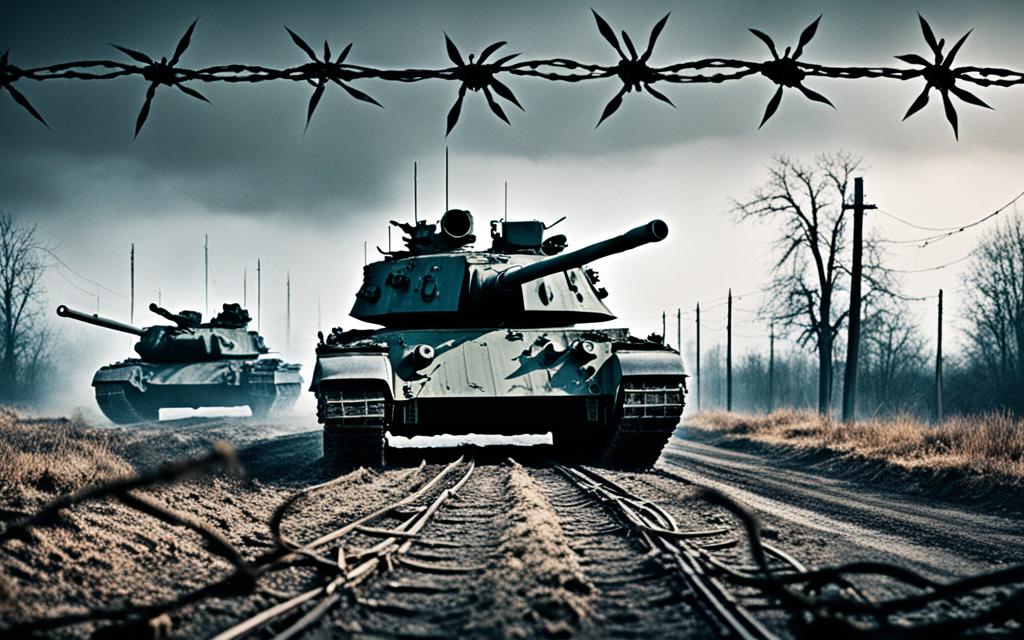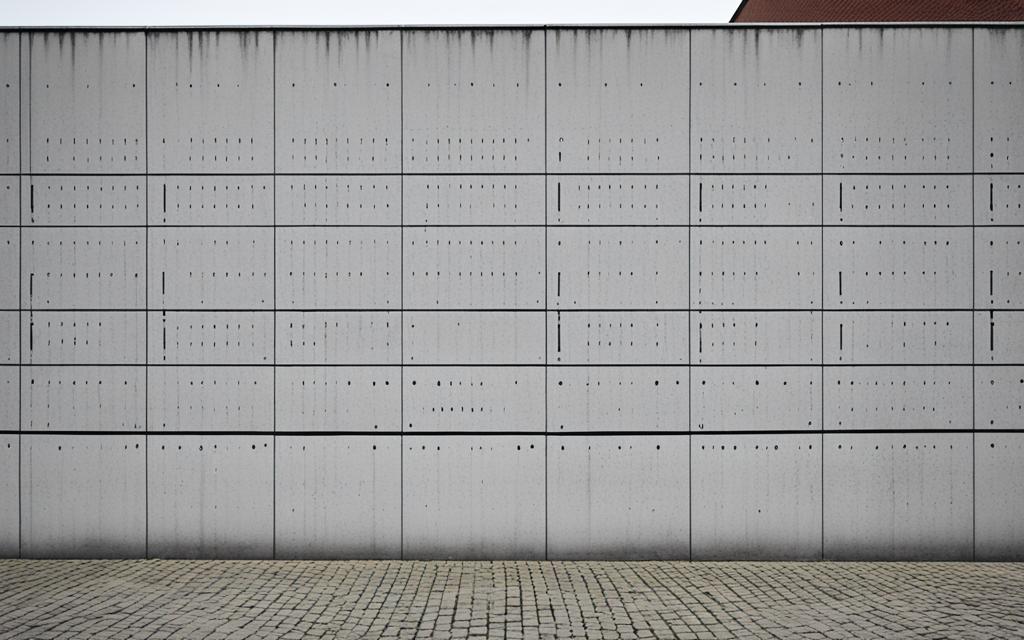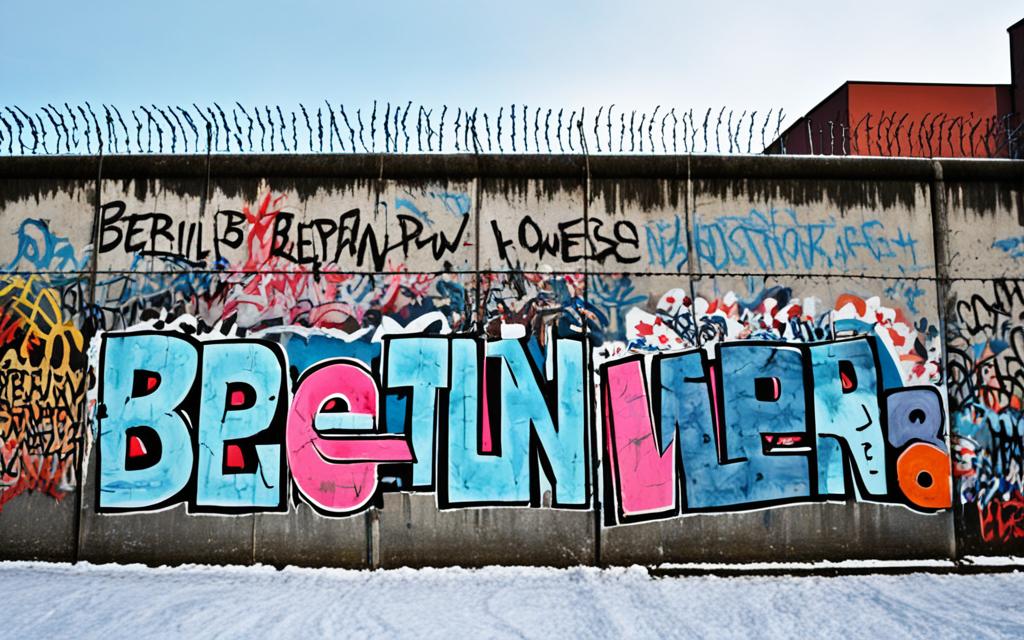As a kid in the United States during the Cold War, I was drawn to the Berlin Wall stories. It was a massive concrete fence with barbed wire and watchtowers. This barrier showed the deep split between communism and capitalism, dividing families and friends. The idea of families being separated filled me with deep sadness and amazement.
I connect deeply with the Berlin Wall’s story because of these personal memories. It was a symbol of oppression for almost thirty years. This structure highlights the tough times for people living near it, as well as the joy when it was finally torn down. This act brought hope and reunification to many.
From 1961 to 1989, the Berlin Wall split the city into two. This barrier was a clear sign of the divide between the free West and the controlled East. It was built to prevent East Germans from escaping to the West. The wall stood for almost thirty years as a sign of the Iron Curtain, separating friends and families.
Key Takeaways
- The Berlin Wall was a heavily fortified concrete barrier that divided Berlin from 1961 to 1989.
- It was a symbol of the ideological and physical divide between the capitalist West and the communist East during the Cold War.
- The wall’s construction was ordered by East Germany to stop the flow of refugees fleeing to the West.
- The Berlin Wall stood as a tangible representation of the Iron Curtain that separated Western Europe from the Eastern Bloc.
- The fall of the Berlin Wall in 1989 was a transformative moment in world history, signaling the reunification of Germany and the end of the Cold War.
Understanding the Cold War Context
The Berlin Wall stood as a symbol of the Cold War era’s tensions. After World War II, Germany was split by the Allies. The Soviet Union took the east, and the Western Allies took the west. This split showed the clash between communism and capitalism that grew after the war.
The Ideological Divide
The Cold War pitted the United States against the Soviet Union. They represented different beliefs. The US stood for capitalist and democratic ideas, while the Soviet Union backed communist and authoritarian ones. This difference showed clearly when Germany was divided.
The Division of Germany
The division of Germany into East and West was due to Cold War tensions. The Soviet Union aimed to spread communism in the east. Meanwhile, the West set up capitalist democracies in the west. This split gave rise to the Iron Curtain, marking the divide between the two parts.
The Formation of East and West Germany
In 1949, East and West Germany were formally created. This action sealed the division along ideological lines. The Berlin Wall was then built, becoming a key symbol of the Cold War and the Iron Curtain.

The Berlin Wall: A Symbol of Oppression
In August 1961, the East German government built the Berlin Wall. This barrier aimed to stop people from moving to the West. At first, it was only a barbed wire fence. But soon, it became a barrier, complete with strong concrete, watchtowers, and alarms. The goal was clear: the East German leaders wanted to keep their people from West Germany.
The Construction of the Wall
The building of the Berlin Wall showed how controlling the East German government was. What was once just a fence turned into a huge, solid wall. It was a sign of the split between East Germany and West Germany. The East German leaders made sure it was tough to get through, using concrete and lots of guards.
Life in a Divided Berlin
The Berlin Wall didn’t just split the city; it changed people’s lives, too. Families found themselves living apart. It became hard to share thoughts and information. Places like Checkpoint Charlie showed just how divided and controlled Berlin was under East German rule.
The Berlin Wall: Facts and Figures
The Berlin Wall stood as a strong barrier for almost 30 years. It cut through the city, spanning 96 miles. The wall was built with concrete and topped with barbed wire. A system of alarms and guards stood watch, making it very hard to cross from East Germany to West Germany.
Dimensions and Statistics
At its highest point, the Berlin Wall reached 11.8 feet. It had a width of 4.3 feet. This made it a massive obstacle for anyone hoping to get to the other side. The size of the wall showed the extreme measures taken to keep people from leaving the East.
Escape Attempts and Casualties
Despite its size, many tried to escape the Berlin Wall. Between 136 and 200 people lost their lives in these attempts. This shows how far the East German government was willing to go to stop citizens from leaving. They wanted to stop the ideas and information of the West from coming into their country.

The Berlin Wall: Historical Significance
The Berlin Wall was not just a barrier. It was a strong symbol showing the divide between the West and the East during the Cold War. This divide was between the market-driven countries like the U.S. and the communists, led by the Soviet Union.
The wall was more than just a physical structure. It represented the ongoing tensions of that time. It was a stark reminder of the separation caused by differing political and economic systems.
The Wall as a Symbol of the Cold War
The Berlin Wall stood as a real-life example of the Iron Curtain. This invisible line divided Western Europe from the communist Eastern Bloc for many years. Its very existence spoke volumes about the stark division that had taken place.
The world was clearly split into two major groups. You either belonged to the capitalist West or the communist East. Each side had its own rules and way of life. The Berlin Wall showcased these differences properly.
The Impact on East-West Relations
The Berlin Wall severely affected how the East and West interacted. It blocked people from easily moving or communicating between these two worlds. This made friendships and cooperation nearly impossible.
For those in the Western democracies, the wall was a terrible symbol of oppression. They saw its erection as a move towards cutting off freedom. The breakup of the wall in 1990 had deep meaning. It showed that this barrier had left a long-lasting impression on the Cold War era.
The Fall of the Berlin Wall
The Berlin Wall came down on November 9, 1989. This moment was huge in history. It broke down years of division and oppression from East Germany’s communist rule. A peaceful revolution in East Germany played a big role in tearing down this symbol of the Cold War.
The Peaceful Revolution
In East Germany, a growing pro-democracy movement emerged. People were inspired by changes in the Soviet Union led by Mikhail Gorbachev. The East Germans organized big protests to demand more freedom. This peaceful revolution, called the Wende, made the East German government open the border. This allowed people to go into West Germany.
The Reunification of Germany
The Berlin Wall’s fall started the reunification of Germany in 1990. This process finished on October 3, 1990. When the wall came down, it ended the Cold War’s division. It was like a big symbolic hug for the German people. This key moment wasn’t just big for Germany. It also changed Europe and the world. It showed the end of the communist times and the start of a new time of working and being together.




